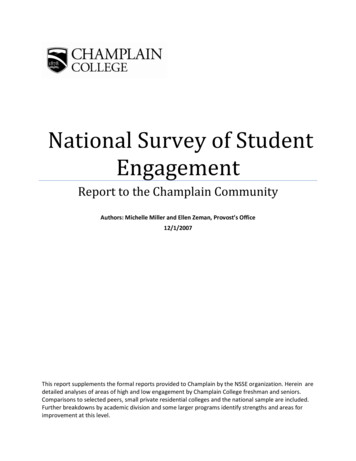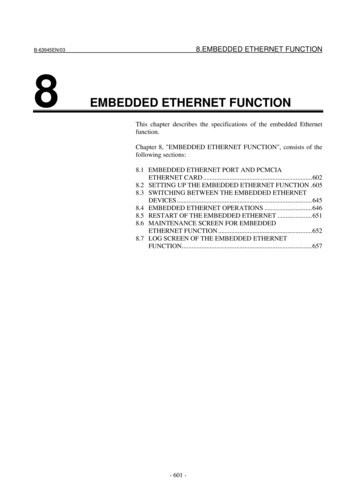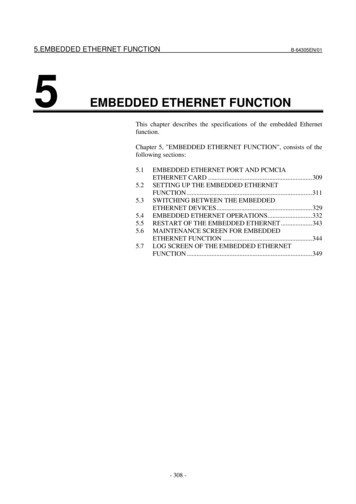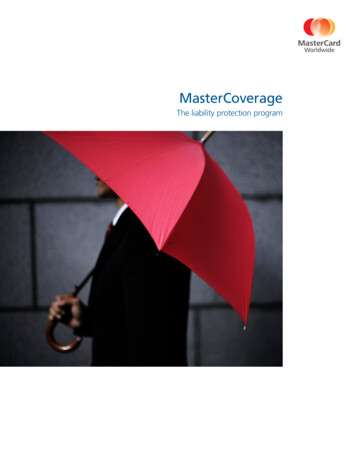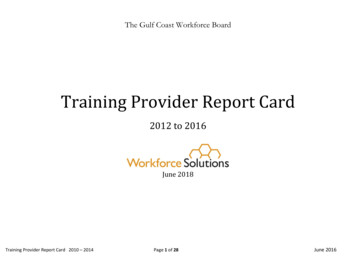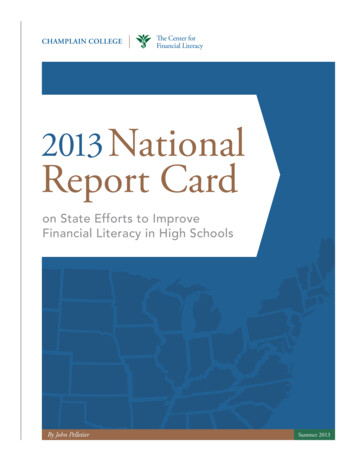
Transcription
CHAMPLAIN COLLEGEThe Center forFinancial Literacy2013 NationalReport Cardon State Efforts to Improve Financial Literacy in High SchoolsBy John PelletierSummer 2013
CHAMPLAIN COLLEGETable of ContentsIntroduction . 1Why High Schools? . 3Methodology . 3Guide to Grading System . 4How Do Grade A & B States Deliver Personal Finance to High School Students? . 6State Assessments by Grade . 7How Can My State Flunk When My Child’s School Has a Personal Finance Class?. 9The Four Keys to High School Literacy . 10What Can Be Done and Is Being Done About Funding . 11What I Can Do To Promote Personal Finance Education. 12State Summaries . 14Sources Used for Grading . 27Extra Credit . 28About the Center for Financial Literacy and Champlain College . 30The Center forFinancial Literacy
CHAMPLAIN COLLEGEThe Center forFinancial LiteracyIntroductionSix years ago this summer, the financial crisis began when the first warning tremorswere felt in our credit markets, and U.S. citizens began to hear new terms likemortgage-backed securities, subprime loans and credit default swaps.The financial crisis and recession also exposed behaviors that indicate low levels offinancial literacy across the nation. Many people purchased homes they could notafford using unsound financial products they did not understand. As a result, mortgagedefaults, foreclosure rates, personal credit defaults and bankruptcy rates reached nearrecord highs.According to the 2013 Consumer Financial Literacy Survey, 43 percent of adults worrythat they do not have enough rainy day savings for an emergency, 31 percent have notsaved anything for retirement, 31 percent have no savings, and 26 percent do not paytheir bills on time. The behaviors underlying this data suggest a severe lack of personalfinance knowledge and skill.1Such negative financial outcomes and low levels of consumer knowledge and confidencehave made it crystal clear that financial literacy in America should be a national priority.Moreover, studies have shown that financial literacy is linked to positive outcomes likewealth accumulation, stock market participation, retirement planning, and avoidinghigh-cost alternative financial services like payday lending and auto title loans.To avoid another financial crisis in the future and to improve personal finance outcomesfor American citizens, our nation must be educated in personal finance. A great place tostart is with our K-12 students. In too many of our states, our youth receive little if anypersonal finance training in middle school, high school and college.1 2013 Consumer Financial LiteracySurvey: es2013/NFCCNBPCA 2013%20FinancialLiteracysurvey datasheet key%20findings 032913.pdf1
CHAMPLAIN COLLEGEWe would not allow a young person to get inthe driver’s seat of a car without requiring driverseducation, and yet we allow our youth to enter thecomplex financial world often without any relatededucation. An uneducated individual armed with acredit card, a student loan and access to a mortgagecan be nearly as dangerous to themselves and theircommunity as a person with no training behind thewheel of a car. Here are a few sobering facts: T he most recent Jump tart Coalitionsurvey shows high-school seniorsfailing on personal-finance tests. 2The teaching of personal finance isoften an afterthought because it is nota subject that students are required tobe tested on in most states. Our children are also not learningthese important life skills at home.Another study showed that parents arenearly as comfortable talking to theirchildren about sex as they are discussingmoney. Really? The “sex talk” with yourchild is nearly as difficult to have as aconversation about spending, saving,and the use of credit? 3Financial literacy in college often consists of exitinterviews for students with federal loans, remindingstudents to repay their loans that averaged 26,600in 2011 for the two-thirds of seniors that graduatedwith debt. This figure does not include privatestudent loan or credit-card debt.4The Center forFinancial LiteracyFor our nation’s youth,learning is often beingdone through personalexperience. Makingmistakes with yourcredit is a painful wayto learn a life lesson.Naturally, we look to our teachers to help solve thisproblem. Yet, a 2009 national study found thatK-12 teachers are not confident in their ability toteach financial literacy.5 But they are as concernedas we all are about this challenge, with 9 out of 10of the same teachers believing such courses shouldbe a high school graduation requirement.As our high school students enjoy their summerbreak, and as schools administrators and teachersbegin to prepare for the new academic year, it isan appropriate time to reflect on how our highschools provide personal finance education totheir students. Champlain College’s Center forFinancial Literacy, using national data, has gradedall 50 states on their efforts to produce financiallyliterate high school graduates. What the gradingshows is that we have a long way to go before weare a financially literate nation.Just 40 percent of states were given grades that youwould want your children to bring home fromschool — grades A or B. Sixty percent of states havegrades of C or less, with 44 percent having failinggrades of D or F. Clearly, as a nation, we should beable to do better.2 http://jumpstart.org/survey.html3 Charles Schwab Teens & Money SurveyFindings: factsheet.pdf4 Student Debt and the Class of 2011by the Project for Student Debt: 011.pdf5 “ Teachers’ Background & Capacity to TeachPersonal Finance: Results of a NationalStudy” by Way and Holden: yResearch/PDF/TNTSalonExecutiveSummary.pdf2
CHAMPLAIN COLLEGEThe Center forFinancial LiteracyWhy High Schools?Personal finance education should start early at bothhome and school, but personal finance educationdata that allows for state-by-state comparisons canonly be gathered at the high school level. There isno national effort to keep track of such data at theelementary and middle school levels.College data is not gathered, and for manyindividuals, educational opportunities end withhigh school anyway. So high school for many is thebeginning of financial independence.choose go on to higher education, personal financeeducation in college is scant and scattered, withfew colleges offering a personal finance elective andeven fewer requiring personal finance instruction asa graduation requirement. For those graduates whoeither do not complete high school or choose not togo to college, they will immediately be thrust into asituation where they need to know how to managetheir daily living expenses. Given these facts, highschool seems like the best and most logical placeto deliver personal finance education to America’syouth.According to the Bureau of Labor Statistics, 68.3percent of 2011 high school graduates were enrolledin colleges or universities. For those graduates whoMethodologyThe state grades in this report are based on areview of financial literacy legislation summariesmaintained by the National Conference of StateLegislatures for the last 14 years (1999 to 2012)6 ;on data compiled by the Jump tart Coalition onPersonal Financial Literacy (their on-line dataon state financial education requirements)7 ; theCouncil for Economic Education’s 2011 Survey ofthe States8 ; and research done on individual stateswhen inconsistencies existed between the varioussources or additional information on a particulartopic was warranted.It is quite possible that some of the grades in thisreport are based on incomplete or inaccurateinformation and thus might be too severe or toolenient for a particular state. We want the gradesto be based on the best information possible,and welcome any corrections or additional data.We encourage you to send any informationthat you believe we should be made aware of tocfl@champlain.edu.6 See page 277 requirements.html8 ads/2011/11/2011-Surveyof-the-States.pdf3
CHAMPLAIN COLLEGEGuide to Grading SystemThe Center for Financial Literacy at Champlain College has graded all 50 stateson their efforts to teach the ABC’s of financial literacy to high school students.The assessments are based primarily on published reports covering state-by-statemeasures, along with reviews of state legislation going back more than a decade.(For an interactive version of this report card, visit the Center’s website atwww.champlain.edu/MakingTheGrade).A quick guide to the grading system:AThe state requires a standalone personal finance course. Alternatively,the state requires that personal finance topics be taught as part ofanother mandatory course and that students’ personal finance knowledgebe assessed.BThe state mandates personal finance education as part of another courseoffering, but requires no assessment. In some cases, there may be a mathcourse that includes a partial assessment of personal finance knowledge.CThe state requires that a personal finance elective course be offered or thatpersonal finance topics be taught, but there is no accountability: No onechecks to see if personal finance is being integrated into a course, and nospecific course is designated as the delivery mechanism. Students are notassessed on these topics.DThe state allows schools to teach personal finance as an elective, but studyis not required for graduation.The state has few requirements, or none at all, for personal finance educationin high school.4The Center forFinancial Literacy
CHAMPLAIN COLLEGEThe Center forFinancial LiteracyThe Center’s grading system is based on the beliefthat, at a minimum, all high school studentsshould be required to take a course that includespersonal finance topics — even if these topics arejust a modest part of the overall course offering. Ifa state did not meet this standard, it was given agrade of C, D or F. The grading system recognizesthe reality that a standalone high school personal14%7 STATESfinance course is often difficult to achieve. Manylocal and state governmental organizations takethe position that adding a personal finance courserequirement is just not possible.State-by-state grades are as follows, with expandedexplanations for each state’s grade in the StateSummaries section at the back of this report:26%13 STATES22%11 STATES16%8 STATES22%11 STATES5
CHAMPLAIN COLLEGEHow Do Grade A & BStates Deliver Personal Financeto High School Students?6COURSE OFFERINGGRADE A & B STATESStandalone Financial Literacy CourseMissouri, Tennessee,Utah and VirginiaPersonal Finance Taught(often in another course) plusStudent AssessmentsGeorgia, Idaho, Louisianaand TennesseeEconomics Course(Social Studies)Arizona, Georgia, Idaho, New Hampshire,New York, North Carolina (also includesCivics), Ohio, South Carolina, SouthDakota, Texas and West VirginiaMathematics Course& Student AssessmentsColorado and KansasConsumer Education CourseIllinoisFree Enterprise CourseLouisianaFinancial, Economics,Business and EntrepreneurialLiteracy CourseNew JerseyThe Center forFinancial Literacy
CHAMPLAIN COLLEGEThe Center forFinancial LiteracyState Assessments by GradeGrade AGeorgia, Idaho, Louisiana, Missouri, Tennessee, Utah & VirginiaVirginia, Utah, Tennessee and Missouri arethe only states earning an A that require a onesemester standalone course in personal finance asa graduation requirement. Tennessee also requiresthat students be given an assessment on personalfinance. Georgia, Idaho and Louisiana offerpersonal finance instruction as part of anothercourse offering and they also require studentassessments on financial literacy topics.Grade BArizona, Colorado, Illinois, Kansas, New Hampshire, New Jersey, New York,North Carolina, Ohio, South Carolina, South Dakota, Texas & West VirginiaColorado and Kansas were given a B because theyrequired personal finance topics to be embeddedin high school mathematics courses and alsoincluded these topics in high school mathematicsassessment exams.Generally, states with a B grade have personal financetopics in their instructional guidelines, and requirelocal school districts to implement them. To graduatefrom high school in a B state, a student must take acourse that includes personal finance topics.Grade CIn this category, all states have personal financetopics in their instructional guidelines, require localschool districts to implement the guidelines, andrequire financial literacy instruction as a high schoolgraduation requirement either as a standalonecourse or as part of another course offering. Someof these states also require that the course includea formal personal finance assessment test given toall students.These states require personal finance topics andembed them in civics, economics, family andconsumer sciences, business or mathematicscourses. The chart on the previous page entitled“How Do Grade A & B States Deliver PersonalFinance Education To High School Students?”shows the different types of courses where personalfinance topics are taught.Indiana, Iowa, Kentucky, Mississippi, Nevada, New Mexico, Oklahoma & WisconsinTwo states earned a C grade because they requirethat each high school offer a personal financecourse as an elective. This at least gives studentsand parents the choice of taking such a course.Other states were given the grade of C because theyrequire specific personal finance topics to be taughtin high school. However, it is left up to the localschool board to determine how and where tointegrate these topics into the classroom. It alsois not clear how the state determines if the localschools are in fact meeting these requirements.7
CHAMPLAIN COLLEGEState Assessments by Grade (continued)Grade DFlorida, Maine, Maryland, Michigan, Minnesota, Montana,North Dakota, Oregon, Pennsylvania, Vermont & WyomingThose states receiving a D grade require thatpersonal finance topics be included in instructionalguidelines and require that the school districtsimplement them. But the content requirementsvary greatly, and schools are not instructed to includethe topics in any course needed for graduation. InGrade D states, personal finance concepts are oftentaught in electives courses, if they are taught at all.How and if these standards are implemented is leftup to the school districts. It is not clear how thestates ensure that the schools teach these topics inthe classroom.Literacy in 2010, which gives awards and grants toindividuals and corporations for financial literacyeducation activities. But, according to the Council,75 percent of Wisconsin school districts do nothave a one semester financial literacy requirement.For 10 years, Wisconsin has hosted the NationalInstitute on Financial & Economic Literacy,which has provided teacher training to more than700 teachers and has an on-line teacher trainingprogram. Wisconsin also created Model AcademicStandards for Personal Financial Literacy for schooldistricts to use when implementing financialliteracy curricula into their classrooms.Wisconsin was raised from a D to a C, earning extracredit for creating an Office of Financial Literacyin 2000 and a Governor’s Council on FinancialGrade FAlabama, Alaska, Arkansas, California, Connecticut, Delaware,Hawaii, Massachusetts, Nebraska, Rhode Island & WashingtonThese states have few requirements, or none at all,for personal finance education in high school.60%OFSTATES40%OFSTATES8The Center forFinancial Literacy
CHAMPLAIN COLLEGEThe Center forFinancial LiteracyHow Can My State FlunkWhen My Child’s SchoolHas a Personal Finance Class?We recognize that there are schools in states inthe grade C, D and F categories that offer andsometimes even mandate personal finance training.Readers may live in such a school district and thusmight be shocked or angered by the grade their statehas received. These wonderful and isolated cases aredue to local control — not a state requirement.Such instruction, when it occurs, is the result ofthe actions of local school boards, superintendents,principals and/or teachers. The states are notrequiring that this be taught. So these pockets ofexcellence are financial literacy islands within eachstate’s educational ocean.Many of the states that have poor grades haveadvocates in their legislature who are trying todo something. In many of these states, bills areroutinely introduced to promote personal financebut are never passed.In Vermont (Grade D), the state where ChamplainCollege’s Center for Financial Literacy is located,the quality of the instruction is entirely dependentupon the support of the local superintendents,principals, school boards and most importantly,the teachers. The technical education students(those entering into trades after graduation) arethe most likely to receive personal finance training.Some high schools offer a personal finance electiveand some do not. Providing a personal financeelective will result in the majority of studentsin that high school graduating without anyfinancial sophistication training. A small handfulof progressive Vermont high schools mandatepersonal finance as a graduation requirement.Vermont is a typical example of a state withgrades D or F.9
CHAMPLAIN COLLEGEThe Four Keys to HighSchool Financial LiteracySo what are the elements of a successful financialliteracy educational program at the high school level?There are four keys to success:1) Financial literacy topics must betaught in a course that students arerequired to take as a graduationrequirement.3) Funding is needed to ensure thatthese classes are offered to all highschool students.4) In order to make sure that the highschool classroom personal financetraining is working, we need to givestudents standard assessments onknowledge and behaviors.2) T eacher training is critical. Toeffectively educate our students aboutpersonal finance, we need confident,well-trained educators.N DIN GSESSEDASFUSUCCESSTR10TRNUIREMEEQAININGThe Center forFinancial Literacy
CHAMPLAIN COLLEGEThe Center forFinancial LiteracyWhat Can Be Done andIs Being Done About FundingFinancial literacy initiatives cost money. How can these new programs be funded in a time of fiscal austerity?One place to look is partnerships with local and national financial institutions. For example, the nationalaccounting firm PwC and Discover Financial Services have both announced large multi-year programs thatsupport bringing financial literacy to our nation’s schools.Another source of funding, advocated by the Center for Financial Literacy at Champlain College, could be thecreation of a National Public Education Foundation for Financial Capability that could receive a percentage ofall fines and penalties paid to federal regulators by financial service companies accused of breaking laws.9 Thefollowing are some of the unique methods used by some states to create a funding mechanism for financialliteracy initiatives: New Jersey passed a law in 2011that authorized credit unions to takedeposits from the state (e.g. tax receipts).In exchange for the ability to be the state’sbankers, the credit unions who acceptedthese funds were required to spend moneyon financial literacy education. Texas has assessed an annual fee oncertain individuals and companieslicensed by the state that participate inthe financial services industry. Such feesare used to fund certain financial literacyeducation initiatives. West Virginia created a ConsumerEducation Fund that is funded by 10percent of all civil penalties collected bythe state’s Division of Banking. Vermont also has a fund, maintainedby the state’s Department of FinancialRegulation (DFR), that is funded bycertain DFR operations. Maine tapped into their unclaimedproperty fund (e.g. financial assets thatescheat to the state) to help fund statefinancial literacy initiatives.9 “Bank scandals can aid financial literacy”at -aid-financialliteracy-2012-11-12 and “Let bad bankspay for financial literacy” at for-financial-literacy-2012-12-0511
CHAMPLAIN COLLEGEThe Center forFinancial LiteracyWhat I Can Do To PromotePersonal Finance EducationIf there is a positive outcome we can realizefrom the Great Recession, it will be to becomea financially literate nation. Perhaps if more ofus proactively support personal finance trainingin our public schools, collegiate institutions andworkplaces, we could prevent another horribleeconomic and financial crisis in the future.If your state has a failing grade, advocate forchanges with your local school principal,superintendent, school board and state legislativerepresentative. You can also partner with yourstate chapter of the Jump tart Coalition, theCouncil for Economic Education, and/or JuniorAchievement. If you want change then you needto get involved.Go to the Jump tart Coalition page called“Making the Case,”10 where you will find lots ofgood information. Armed with that information,meet with your local high school principal orschool board and convince them that personalfinance should be part of the curriculum. On thestate level, you should contact your local staterepresentative or senator. Given that our nationhas suffered greatly in recent years from financialilliteracy, elected officials should listen closely toand hopefully act on your argument.The Center for Financial Literacy at Champlainrecognizes that the lack of teacher trainingis a major barrier to quality personal financeeducation. We have offered a graduate levelcourse for teachers in Vermont for the past threesummers. The goal of the course is simple — wewant middle and high school teachers to leave this45 hour course taught by more than 25 instructorswith the confidence, skills and curriculum toolsthat they need to successfully bring personalfinance instruction into their classroom.Champlain College’s educator training programis a proud member of the Jump tart TeacherTraining Alliance Program. This program has beenthrough a multi-year pilot program and is nowbeing made available nationally to other partnersinterested in providing similar teacher training intheir states.11 Their training program is based onrigorous measurement of teacher confidence andbehaviors.12 Perhaps you can partner with localleaders to put on a similar training program forteachers in your state.Most states have adopted the Common CoreState Standards for mathematics and languagearts, to be implemented by 2015. These neweducation standards require students to thinkmathematically about real-world issues. What’smore real than creating a budget, getting acredit card, applying for a loan and saving forretirement? Our nation has a unique opportunityto leverage these standards to provide criticalpersonal finance skills to our youth. You can usethe curriculum changes that are about to happenin most states as a catalyst for change in yourschool districts. Get involved in discussions onthis important change — attend school boardmeetings.10 literacy-2013.html11 Jump tart Teacher Training alliance.html12 “ Research Report: Content-Based TeacherProfessional Development Pilot Project”by Hensley: liance/J TTA%20Pilot%20Research%20Report.pdf12
CHAMPLAIN COLLEGEThe Center forFinancial LiteracyWhat I Can Do To PromotePersonal Finance Education (continued)Additional Information on theCommon Core State StandardsThe following excerpt is from the final reportfrom President Obama’s Advisory Council onFinancial Capability regarding this opportunityto use the Common Core Standards as a way ofaffecting change: Forty-five states and the District ofColumbia recently banded togetherto adopt the Common Core StateStandards in K-12 mathematics andEnglish Language Arts designed toprepare students for success in collegeand careers. As a result, educators areworking hard to ensure that teachingand learning reflect these new standardsfor academic knowledge and skills andprovide students the opportunity toapply their knowledge in real worldcontexts. While personal finance classeswill remain (and hopefully grow) aselective offerings, by connecting personalfinance to what students are learningin their core classes, we can strengthenboth the teaching of personal financeand the teaching of the Common CoreState Standards.The Council has identified key next steps onthe path towards this goal. These include:immediately mapping how essential personalfinance knowledge and skills can be integratedinto teaching of the Common Core StateStandards and, over time, coalescing around oneset of personal finance standards for the field;developing a robust, web-based set of high qualityand easily accessible tools and materials, includingmathematical tasks and identification of nonfiction texts and close reading exemplars; aligningexisting personal finance programs with thedemands of the Common Core State Standards;and investing in research and evaluation onthe teaching of financial literacy. Collaborationamong Council members, developers and leadersof the Common Core State Standards, financialeducation experts and teachers has already led to aninitial mapping showing where essential personalfinance concepts and skills can appropriately beintegrated into teaching of the standards as wellas to the development of mathematical tasks andidentification of non-fiction texts. A new website,www.MoneyAsYouLearn.org, offers guidance toteachers and school districts through lesson plans,problem sets, nonfiction texts and other resourcesthat elucidate the topic of personal finance withinthe context of the Common Core.13
CHAMPLAIN COLLEGEThe Center forFinancial LiteracyState SummariesAlabamaGrade F Personal finance topics are includedin the state’s educational guidelinesbut the state does not require thatlocal school districts teach thesetopics. (Source: CEE Survey) No personal finance requirement,although personal finance maybe taught at certain schools as anelective. (Source: Jump tart Survey) In 2010, Alabama passed a law“urging” the department of educationto incorporate personal finance intocurriculum for high school seniors.(Source: NCSL Summaries)AlaskaGrade F Does not include personal financetopics in the state’s educationalstandards. (Source: CEE Survey) No personal finance requirement,although personal finance maybe taught at certain schools as anelective. (Source: Jump tart Survey)ArizonaGrade B Requires personal finance instructionto be incorporated into other subjectmatter. (Source: Jump tart Survey) Includes personal finance topicsin the state’s K-12 instructionalguidelines and requires localschool districts to implement thesestandards. (Source: CEE Survey) Arizona requires an economicscourse that includes personal financeconcepts beginning with the class of2012. (Source: Jump tart Survey) Note: the Jump tart Survey indicatesthat a course with personal financetopics must be taken as a graduationrequirement; however the CEE Surveydoes not identify this requirement. Thegrade is based on the Jump tart data.14ArkansasGrade F Personal finance topics are includedin the state’s educational guidelinesbut the state does not require thatlocal school districts teach thesetopics. (Source: CEE Survey) No personal finance requirement,although personal finance maybe taught at certain schools as anelective. (Source: Jump tart Survey) In 2002, Arkansas passed a law thatprovides assistance to school districtsthat want to offer personal financein high schools. (Source: NCSLSummaries)CaliforniaGrade F Does not include personal financetopics in the state’s educationalstandards. (Source: CEE Survey) No personal finance requirement,although personal finance maybe taught at certain schools as anelective. (Source: Jump tart Survey) In 2004 the state legislature“encouraged” and “urged” therelevant education officials to dosomething and like many other statesthe state declared April financialliteracy month. Six financial literacybills were vetoed by the Governorfrom 2006 through 2010. In 2011a fund was established that wouldaccept private donations that couldbe used to promote financial literacyin California. (Source: NCSLSummaries)
CHAMPLAIN COLLEGEThe Center forFinancial LiteracyColoradoGrade B Includes personal finance topicsin the state’s K-12 instructionalguidelines and requires localschool districts to implement thesestandards. (Source: CEE Survey) Requires personal finance instructionto be incorporated into other subjectmatter. (Source: Jump tart Survey) Colorado requires financial literacytopics to be included in the modelcontent standards for mathematics.Requires certain personal finance
findings_032913.pdf 1. CHAMPLAIN COLLEGE fie Center for Financial Literacy . to enter the complex financial world often without any related education. An uneducated individual armed with a credit card, a student loan and access to a mortgage can be nearly as dangerous to themselves and their . go to

